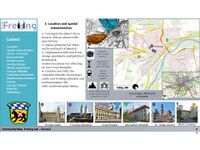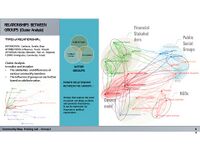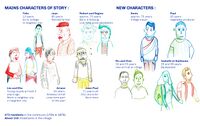LED2LEAP 2020 - Freising Team 2
>>>back to working groups overview
Landscape Democracy Rationale
- Why do you think this community context is relevant from a landscape democracy perspective? What is your hypothesis considering the landscape democracy challenges?
We believe that we can solve the problems in question in order to Democratic landscape perspective in Freising.
It means that there is capacity to see the broad picture on Integrated actions at the landscape scale in Freising which allow groups to evolve dynamically.
ASSUMPTIONS:
All communities and Voices are equel.
Individuels have the ability to make changes.
Every group has its own values.
Location and scope
- The Location is located in Freising.
- Our main focus area is the old town of Freising.
Phase A: Mapping your Community
Groups of actors and stakeholders in your community
- Which groups/sub-communities are there? What are their needs and aspirations with regard to the landscape? Which groups are more visible? Which are less visible? What do we not know?
Social Groups:
- political actors (Political parties, politicians )
- NGOs ( Environmental “German Environmental Aid Association”, social ”Caritas”, health “Gesundheitszentrum Kneippgarten”, Human rights … ) ( Non-profitable )
- public groups ( elderly, parent students, , single parents, adolescents ,International students, )
- Brands’ customers ( Apple, Adidas, Nike, ..etc )
- competitors ( sports clubs )
====================================================================================
Local Stakeholders:
- Retailers
- Breweries
- Associations ( City Marketing Association, Inner city management Association,City Economic Development Agency,.... etc)
- Religious Organizations
- Profitable Organizations.
NEEDS
====================================================================================
*External Stakeholders:
- Financial stakeholders: (Banks, Shareholders, Insurance Companies, Construction Companies)
- Governmental Groups: (National Authorities ( Mayor, City Council, ... etc), Government offices, Education System, Health System)
Relationships between your actors and groups
- How would you describe the power relationship between the groups?
- Which groups may have shared interests and which are these? (max 200 signs)
- add 1-2 graphical representations to the image gallery based on your PPT presentation, you can add more if you like
Summary of your learnings from the transnational discussion panel on April 22
On April 22 you will present the PPT version of this first assignment to other seminar groups working in other geographical community contexts. Please give here a short summary of your learnings during this presentation, for example:
- Other analytical approaches
- Other representation styles
- Other value schemes: any surprises?
- Constructive comments we received on our presentation
Theory reflection
- Reflect on at least three readings from the first section 'Democratic Landscape Transformation
- You can choose references from our reading list or suggest others
- Scope: 250 words
References
- give a full list of the references you have used for this section
Phase B: Democratic Landscape Analysis and Assessment
The Scene in your Story of Analysis
- Describe your landscape democracy challenge. What is the physical scene, specific description of the landscape? What are the socio-economic and political characteristics of place? Are there any important contextual elements?
- add the corresponding visual from your presentation to the image gallery below
- Yourcase scene1.jpg
add a caption
The Actors in your Story of Analysis
- Describe the characters and their role in the story. Are they major or minor characters? Are there any key relationships that need to be defined?
- add the corresponding visual from your presentation to the image gallery below
The Story of Analysis
- Describe the plot of the story and how it plays out.
- add the corresponding visual from your presentation to the image gallery below
- add as many additional images as you like
- Yourcase story2.jpg
add a caption
Reflect on your Story of Analysis
- How did the tools you chose for landscape analysis fit your community? Reflect on the questions: What did you carry? Why did you carry? How did you carry? What remains after you've left? (150 words)
- add the corresponding visual from your presentation to the image gallery below
- Yourcase refelction1.jpg
add a caption
Phase C: Collaborative Visioning and Goal Setting
* template coming
Phase D: Collaborative Design, Transformation and Planning
* template coming
Phase E: Collaborative Design, Transformation and Planning
* template coming
= Phase E: Collaborative Evaluation and Future Agendas * template coming
Process Reflection
- Reflect in your intercultural and interdisciplinary team on the outcomes of your study
- Which limitations were you facing?
- What have you learnt from each other?
- What would you do differently next time?
- You can also use diagrams/visuals
- 250 words text









